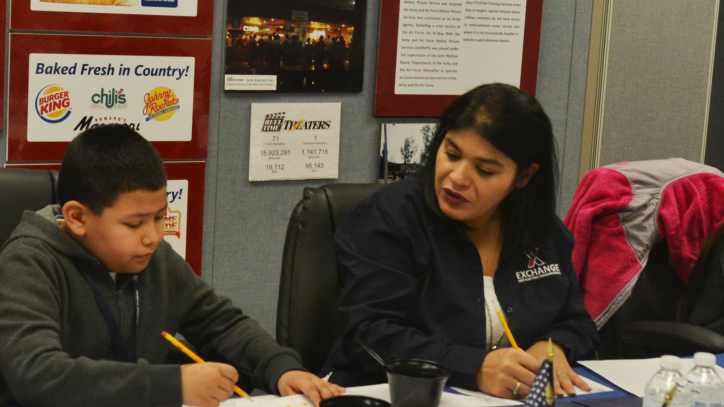‘A Taste of Home’

Exchange Enlists Help from Students at Dallas’ Advantage Academy to Taste-Test School Meal Options for Military Kids Overseas
For the Exchange’s school meal program, finding out what new menu options military children living overseas are most likely to enjoy most can be a challenge—especially when the students in question live as far as 6,000 miles away.

Chrissy Quintero, Army & Air Force Exchange Service inventory specialist, helps third-grader Juan David Rodea give feedback on a meal option under consideration for overseas Department of Defense school cafeterias on March 2 at the Exchange’s Dallas headquarters. Rodea was one of six students from Advantage Academy’s North Duncanville campus to taste-test potential new menu items for the Exchange’s overseas school meal program, which oversees meals 78 DOD school cafeterias in Europe and the Pacific.
To help the Exchange’s Services and Food Directorate meet this challenge, six second- through seventh-graders from Advantage Academy’s North Duncanville campus came to Exchange headquarters on March 2 for a special “taste-test” event at the Exchange’s on-site test kitchen.
“We have had several tastings at our headquarters with adult subjects, and the feedback we’ve received so far has been positive,” said Dora Rivas, Exchange staff dietitian. “However, a child’s palate is very different from a grown-up’s. It’s important we hear from the experts—the kids themselves—to evaluate how successful we could expect these offerings to be among military children living overseas.”
The feedback provided by Advantage Academy students will be weighed alongside survey results from overseas students and parents, as well as the results of a competitive bidding process among food vendors, to drive possible menu changes for the 2018 school year.
Brian Roberts, an Advantage Academy second-grader who participated in the event, has a military connection of his own, his father having served in the Navy. He said he enjoyed evaluating the various menu items—especially broccoli cheese soup, a dish he had never tried before.
“It makes us feel good that we’re helping kids all over the world be healthy,” Roberts said.
After the taste-testing, Trinidad Saucedo, the Exchange’s senior vice president of services, food and fuel, came to the test kitchen to personally thank the students and Ms. White for offering their support to military children living overseas. Saucedo presented each student with a special certificate designating them as Exchange student ambassadors.
“It is critical we ensure our school meal options will be well-received by students living and attending school overseas,” Saucedo said. “The feedback provided by these students today will help the Exchange give these children a lifeline to America by providing them with the options and flavors that remind them of home.”
Advantage Academy Principal Donita White said the school was happy to have its students help the Exchange support military students living overseas, adding that the event helped drive home the importance of helping others—no matter how far away they may be—to the students.
“Food is a common language, and maybe if I like something, a kid in another country might like it, and I can help bring them a taste of home,” she said.
The Exchange’s school meal program provides school lunches below cost to Warfighters’ children at 78 Department of Defense (DoD) schools in Europe and the Pacific. The Exchange also operates seven overseas plants including four bakeries that provide whole-grain-rich baked goods—all made using American flour—to DOD school cafeterias overseas.

Second-grader Brian Roberts fills out a feedback card during a March 2 taste-testing event for the Army & Air Force Exchange Service’s school meal program. Roberts was one of six students from Advantage Academy’s North Duncanville campus to come to the test kitchen at Exchange headquarters to help officials determine which menu options Warfighters’ children are most likely to enjoy at 78 Department of Defense school cafeterias in Europe and the Pacific.

